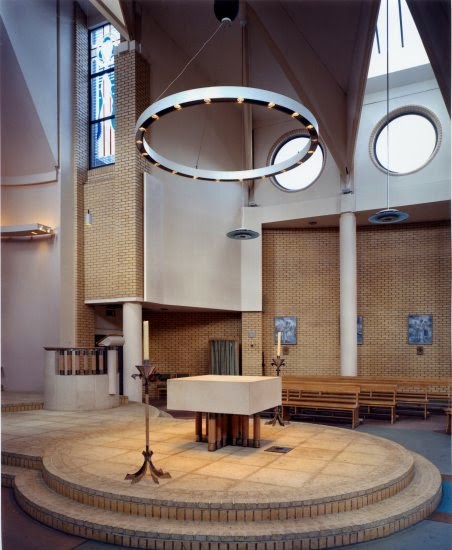Once upon a long lost time ago, the altar server, knowing that the priest he served was about to consecrate the host into the Body of God, would kiss the hands of the priest as he received his Berreta(hats priests once wore during parts of the liturgy), and knowing that the water and wine that poured forth from the cruets were to become the blood that streamed from Christ's side to revive the bones of Adam, the server kissed the cruets when he handed them to the priest and when he received them back. The sacristan if not given explicit permission to touch the sacred vessels, wore white gloves, because the Church rightly knew, as well as he, that he was unworthy to touch the vessels which would contain God Himself.
And the faithful, full of reverence, approached fearfully to kneel before the Lord, to receive Him into themselves in the Eucharist. For as the Angelic Doctor, St. Thomas Aquinas states "...because out of reverence towards this sacrament, nothing touches it but what is consecrated, and likewise the priest's hands, for touching this sacrament. Hence it is not lawful for anyone to touch it, except for necessity, for instance if it were to fall upon the ground, or else in some other case of urgency."-ST III Q 82 Art 3
Man used to kneel before his Creator, he spent the majority of the Holy Mass on his knees, and rightly so. For the Church directed, so that man, by his outward posture was informed internally to the magnificent reality that was unfolding before his eyes, of which he was unworthy to partake in.
Have not these noble and sacred traditions served the faithful dutifully, preserving and passing on the faith for ages?
But today, we declare it is no longer necessary for man to kneel! His kneeling is of no importance, it hurts too much and is far to inconvenient. It is not important, to prostrate yourself before He that created you, redeemed you, and sustains you in existence? We endeavor to over-spiritualize worship, neglecting the reality that man is body and soul. Man worships with both his body and his soul, each informing the other.
We would do well to note that the first time that kneeling was purged from christian worship was in protestant churches, who did not want their congregations to worship the host. They understood better than we do now that "External actions are signs of internal reverence."-ST II-II Q 84, Art 1.
Cardinal Schneider tells us in his book Dominus Est-It is the Lord! "On the other hand, Zwingli, Calvin, and their successors, who denied the Real Presence introduced...Communion given on the hand and standing" and a paragraph later "Very early the people(protestants) might have knelt during during the prayer(Lord's Supper) and also received Communion kneeling but... several synods forbade this in order to avoid any suggestion that the bread was to be venerated."
We follow liturgical postures in the footsteps of those who do not believe in the Real Presence, and who actually abolished kneeling to rid their congregations of this belief, and then wonder why one third of Catholics do not believe in the doctrine of the Real Presence. Have we still not accepted the overwhelmingly likely chance, that Catholics don't believe in the Real Presence because we no longer treat Christ like He is actually there...
What does it say when a catholic receives the Eucharist as casually as a protestant receives his wafer at his own service?
It only takes a short look to see that reverence has been removed from our churches, by direct order and by omission, for far too long, and undeniably to the detriment of the Catholic Faith. The Church must now work harder than ever to once again show terribly uncatechized Catholics that their faith has depth, meaning, and is in fact the true faith; that it is not simply a wish-washy feely-goody banners and balloons church, but that it can withstand the meticulous scrutiny of doubters and possesses truths worth dying for.
Certainly Catholics of today have been taught that obvious forms of lack of respect are acceptable, as I have been taught, and certainly they are not bad people for this. On the contrary they are the faithful who have looked to their shepherds, and have been told that reverence is no longer a mainstay of catholic life and devotion. And so I do not criticize the Catholics who receive in any manner, but instead I make a call for a reevaluation of the diminution of traditional reverence.
For half a century Holy Mother Church has tried an approach of relative laxity in enforcement and catechesis as to reverence. Can we say that anything positive has come from it? What has been the gain? What good fruits have come from the abolition of conscientious reverence and where are these fruits? Maybe it is time to once again change course, and return to more formal emphasis and instruction on due reverence in the House of God.
Certainly the future will contain more of my thoughts on this subject, and in further detail, but suffice it to say this much for now.



No comments:
Post a Comment